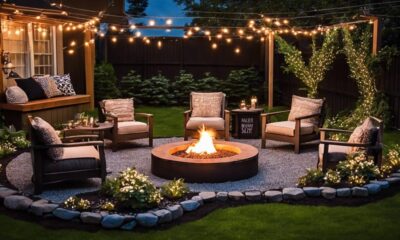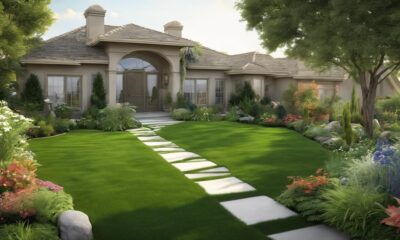Architecture Home Styles
10 Reasons Not to Build a Pole Barn
Hesitant about building a pole barn? Uncover the hidden reason among these ten drawbacks that could change your perspective.

As we navigate the landscape of construction options, considering a pole barn might seem as tempting as a freshly baked pie cooling on a windowsill.
However, before taking the plunge into this seemingly straightforward project, it's crucial to pause and reflect on potential drawbacks that could catch even the most prepared individual off guard.
One particular reason, nestled among the list of ten, might shed light on a crucial aspect that could influence your decision-making process significantly.
Key Takeaways
- Maintenance challenges like regular inspections and structural upkeep impact pole barn durability.
- Design limitations restrict personalization options and architectural creativity.
- Regulatory hurdles involving zoning laws and compliance with ordinances can complicate pole barn construction.
- Insulation difficulties and energy efficiency concerns pose significant challenges in pole barn construction.
High Maintenance Requirements
Maintaining a pole barn involves diligent care and regular inspections to safeguard against weather-related damage, fire hazards, termite infestations, leaks, and rot. Due to the pole barn's construction style, it has high maintenance requirements compared to traditional homes.
The exposed poles and metal sheeting make pole barns more susceptible to various forms of damage. To combat these vulnerabilities, tasks such as sealing gaps, painting to prevent corrosion, and inspecting for structural weaknesses are crucial.
The risk of structural damage in pole barns necessitates consistent upkeep to avoid costly repairs or even complete replacements. Addressing maintenance issues promptly is essential to mitigate the risks associated with the structural vulnerabilities inherent in pole barns.
Limited Customization Options
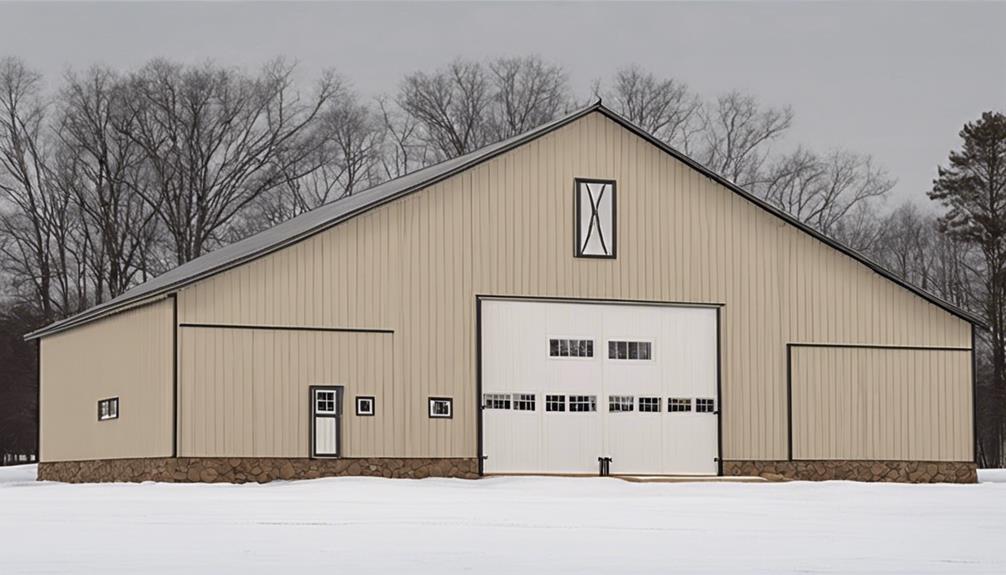
When considering the limited customization options in pole barn construction, it's essential to acknowledge the design restrictions that come into play. These constraints can significantly impact the ability to incorporate personalized features like overhangs, extra doors, or windows.
Moreover, the few material choices available in pole barns may further limit the scope for aesthetic enhancements and architectural creativity.
Design Restrictions
Limited customization options in pole barn construction often result in restrictions on architectural creativity and design flexibility. When it comes to designing a pole barn, certain limitations hinder the freedom to create a truly unique space. Here are four key design restrictions to consider:
- Challenges with Building Intricate Architectural Features: The simplistic nature of pole barns may make it difficult to incorporate intricate architectural details.
- Limited Options for Exterior Aesthetics: Due to the straightforward design of pole barns, there are restrictions on the exterior appearance that can be achieved.
- Difficulty in Customizing Interior Walls: The presence of load-bearing poles can limit the flexibility in creating interior walls to divide the space effectively.
- Adherence to Building Codes: Strict building codes may further restrict innovative design choices in pole barn construction.
Few Material Choices
Pole barn construction restricts material choices, thereby limiting customization options for exterior finishes and architectural details. When opting for a pole barn, the selection is generally confined to metal or wood siding, offering minimal variation compared to conventional construction methods. This constraint can impede the ability to achieve a unique or specific aesthetic, as the choices for exterior cladding are restricted. To illustrate the restricted options, consider the table below:
| Material Choices | Exterior Finishes | Architectural Details |
|---|---|---|
| Metal Siding | Limited options | Basic designs |
| Wood Siding | Rustic appearance | Traditional features |
These limitations often necessitate additional expenses to modify the exterior appearance, highlighting the challenge of achieving a personalized look within the constraints of pole barn construction.
Potential Zoning Restrictions
We must consider the impact of zoning laws on pole barn construction. Location-specific regulations dictate the permissible size, height, and appearance of such structures.
Compliance with these ordinances is vital to avoid penalties or removal orders.
Zoning Laws Impact
Zoning laws play a critical role in dictating the permissibility and parameters of pole barn construction in various jurisdictions. These laws encompass regulations on size, height, location, and architectural congruence with existing structures. When considering pole barn construction, understanding the impact of zoning laws is essential.
Here are four key points to consider:
- Zoning Laws: These regulations can restrict the construction of pole barns based on property use ordinances.
- Compliance with Setback Requirements: Ensuring adherence to setback regulations is crucial to avoid violations.
- Architectural Style: Some areas may require pole barns to match the architectural style of existing structures.
- Property Line Regulations: Understanding and complying with property line regulations is vital to a successful pole barn project.
Location-Specific Regulations Apply
Navigating location-specific regulations when planning a pole barn construction project requires a thorough understanding of the specific zoning restrictions that apply to the intended area. Zoning laws play a critical role in determining whether a pole barn can be built on a particular property.
Homeowners Associations (HOAs) often have strict guidelines that prohibit pole barns in residential areas to maintain uniformity and aesthetic appeal. These regulations may include restrictions on the size, height, or even the color of the structure.
It's essential to carefully research and comply with these zoning laws to avoid potential legal issues or the costly consequences of having to dismantle a non-compliant pole barn. By adhering to these regulations, one can ensure a smooth construction process and a structure that meets all necessary requirements.
Compliance With Ordinances
Compliance with local ordinances regarding zoning restrictions is paramount when considering the construction of a pole barn. Understanding zoning ordinances is crucial to ensure adherence to regulations.
Here are key points to consider:
- Zoning ordinances may restrict pole barn construction in specific areas.
- Regulations often dictate the size, height, and location of pole barns on a property.
- Compliance with setback requirements and property line distances is essential.
- Some residential areas may prohibit pole barns due to aesthetic considerations.
Prior knowledge of local zoning laws is vital for a successful pole barn project. It's imperative to assess and adhere to these regulations to avoid potential setbacks.
Susceptibility to Pests and Rodents

Pole barns exhibit heightened vulnerability to pest and rodent infiltration due to structural gaps that serve as entry points for these unwanted intruders. The gaps in pole barn construction, particularly around the foundation and walls, provide easy access for rodents like mice and pests such as termites.
Once inside, these intruders can wreak havoc on the wooden components of a pole barn, potentially compromising its structural integrity. To mitigate this risk, proper pest control measures are crucial. Regular inspections and prompt sealing of any entry points are essential to prevent infestations and the damage they bring.
Ignoring pest and rodent issues in pole barns can lead to costly repairs and structural damage. Therefore, addressing these vulnerabilities proactively is key to maintaining the longevity and functionality of a pole barn.
Challenges With Insulation and Energy Efficiency

Given the susceptibility of pole barns to pest and rodent infiltration, addressing challenges with insulation and energy efficiency becomes a critical aspect of maintaining the structural integrity and functionality of these structures. When it comes to insulating pole barns, the unique open framing design poses difficulties compared to traditional stick-built structures. Ensuring energy efficiency in pole barns is paramount, as improper insulation can lead to compromised thermal performance.
Here are four key considerations regarding insulating pole barns and enhancing energy efficiency:
- Complex Insulation Process: The open framing of pole barns requires careful planning and specialized techniques for effective insulation.
- Potential Energy Loss: Uninsulated pole barns are prone to heat loss and air leakage, leading to increased energy consumption and costs.
- Comfort and Temperature Control: Proper insulation is essential for maintaining comfortable indoor temperatures and optimizing energy efficiency.
- Additional Materials and Techniques: Achieving optimal energy efficiency in pole barns may necessitate the use of supplementary insulation materials and construction methods.
Long-Term Durability Concerns
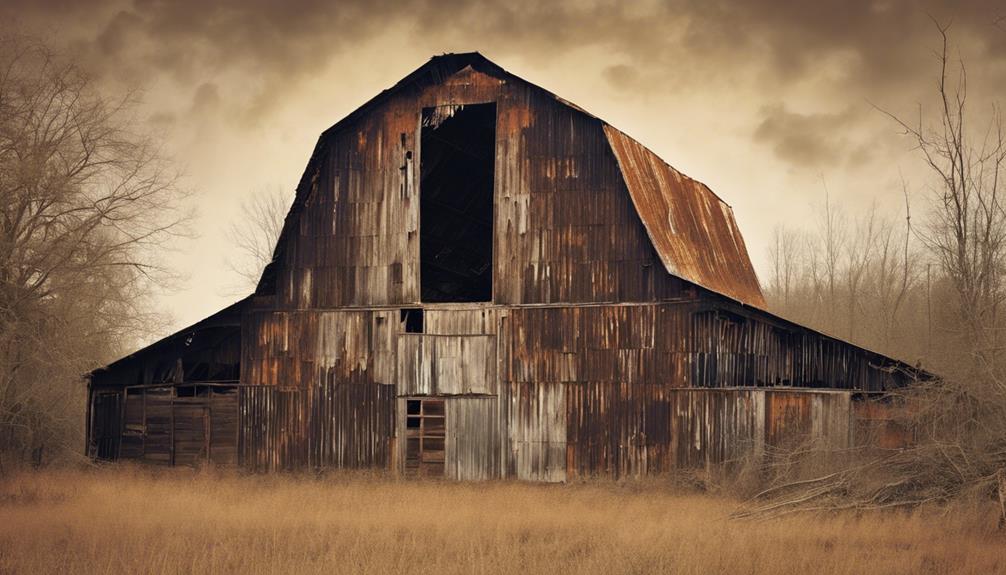
When examining long-term durability concerns associated with pole barns, it becomes imperative to address issues such as structural integrity and maintenance challenges.
Post rot over time and exposure to varying weather conditions can impact the longevity of pole buildings.
Structural Integrity
Our assessment of structural integrity in the context of long-term durability concerns reveals significant vulnerabilities that may compromise the overall stability of pole barn constructions. When considering the implications of rot issues and structural integrity, it's vital to address the following:
- Material Selection: Opting for high-quality, rot-resistant materials is paramount in ensuring the longevity of a pole barn.
- Foundation Strength: A robust foundation is essential to support the structure and prevent potential structural weaknesses over time.
- Proper Construction Techniques: Employing precise construction methods by skilled professionals can mitigate structural integrity issues.
- Regular Inspections: Conducting routine inspections to identify and rectify any early signs of decay or structural compromise is crucial for maintaining the integrity of the pole barn.
Maintenance Challenges
To ensure the long-term durability of pole barn structures, meticulous maintenance practices are imperative to mitigate potential challenges and uphold structural integrity. Pole barns present maintenance challenges due to their vulnerability to severe weather conditions, which can cause damage like leaks, termite infestations, and rot.
These long-term durability concerns necessitate additional protective measures to prolong the lifespan of pole barns, increasing maintenance requirements. Over time, the structural integrity of pole barns may deteriorate, demanding attention to prevent maintenance issues.
In comparison to traditional homes, pole barns typically require more frequent maintenance to guarantee longevity and durability. Addressing these maintenance challenges is crucial for preserving the structural soundness of pole barns and ensuring their continued functionality.
High Upfront Costs

Incurring high upfront costs is a significant consideration when planning to build a pole barn. The initial investment can be substantial, encompassing various expenses beyond just the construction of the structure.
Here are four key points to consider regarding the high upfront costs of building a pole barn:
- Comprehensive Expenses: Building a pole barn involves costs such as site preparation, concrete work, foundation, interior finishes, permits, and landscaping, which can add up quickly.
- Varied Cost Range: The cost of a pole barn can vary significantly based on size and complexity, with a 40 x 60 pole barn ranging from $84,000 to $120,000, and larger ones with living quarters costing $375,000 to $625,000.
- Unforeseen Expenses: Initial cost estimates may not cover all necessary expenses, leading to potential budget overruns.
- Additional Customization Costs: Tailoring the pole barn to match the main residence or adding design improvements can further escalate the upfront expenses.
Limited Resale Value

Considering the limited resale value of pole barns in the real estate market, it is crucial to evaluate various factors that contribute to their depreciated worth. When compared to traditional stick-built homes, pole barns often fetch lower prices due to their perceived durability and aesthetic appeal. Potential buyers tend to favor traditional homes, leading to a limited demand for pole barns and subsequently impacting their resale value. Additionally, factors such as maintenance requirements, aging appearance, and structural concerns can further reduce the attractiveness of pole barns in the resale market. Despite the option to invest in upgrades or improvements to potentially enhance the resale value of a pole barn, these efforts may not always offset the initial cost savings associated with constructing such buildings.
| Factors Contributing to Limited Resale Value of Pole Barns |
|---|
| Perceived durability and aesthetic appeal |
| Preference for traditional homes by buyers |
| Limited demand in the real estate market |
| Maintenance requirements and aging appearance |
| Structural concerns and potential need for upgrades |
Weather Vulnerability

Due to their construction with fewer load-bearing walls and open spaces, pole barns are more vulnerable to weather damage. This inherent design characteristic exposes pole barns to various weather vulnerabilities that can compromise their structural integrity and longevity. Here are four key points highlighting the weather vulnerabilities associated with pole barns:
- Structural Impact: High winds, heavy snow loads, and extreme weather events can exert significant pressure on pole barns, potentially causing structural damage.
- Limited Protection: The open design of pole barns offers limited protection from elements like rain, hail, and storms, increasing the risk of water damage and deterioration over time.
- Maintenance Requirements: Weather vulnerabilities in pole barns may necessitate additional maintenance efforts and reinforcement to enhance their ability to withstand harsh weather conditions effectively.
- Risk to Longevity: Severe weather conditions pose a notable risk to the longevity and stability of pole barn structures, emphasizing the importance of considering weather factors in construction decisions.
Understanding these weather vulnerabilities is crucial for making informed choices regarding the construction and maintenance of pole barns.
Permits and Building Code Compliance

Navigating the complexities of permit acquisition and building code adherence for pole barn construction demands strategic planning and meticulous attention to detail. Obtaining permits for a pole barn can present challenges due to the varying regulations and requirements across different regions. Some areas impose restrictions on pole barns, mandating compliance with specific design or aesthetic standards, further complicating the permit process.
Building code compliance for pole barns is intricate and may necessitate costly modifications to meet regulatory standards. The costs associated with permits for pole barns can vary significantly, ranging from zero to several thousand dollars, impacting the overall project budget.
Engaging with experienced professionals familiar with the permit process can streamline proceedings and ensure adherence to building codes, minimizing the risk of delays or non-compliance issues. By prioritizing permit acquisition and building code compliance, individuals can mitigate potential obstacles and foster a smoother construction experience.
Frequently Asked Questions
What Are the Negatives of Pole Barns?
When considering pole barns, it's essential to acknowledge their drawbacks. These structures may lack aesthetic appeal and durability compared to traditional homes. Maintenance issues like leaks, termites, and rot are more common with pole barns.
Fire damage is also a significant concern due to construction materials. While cost-effective initially, pole barns may not offer the long-term quality found in stick-built homes.
Why Not Build a Pole Barn?
We should consider not building a pole barn due to the potential drawbacks associated with their construction. Despite their cost-effectiveness, pole barns may lack the structural integrity and durability needed in various settings.
This can lead to higher maintenance costs and increased risks from severe weather or pests. Understanding these factors is crucial in making an informed decision when choosing a building style for our property.
Are Pole Barns Worth the Money?
Pole barns are worth the money due to their cost-effectiveness and flexibility. They offer a 20-30% cost savings compared to traditional homes and can be easily customized to suit various needs.
Pre-engineered kits streamline construction, saving on materials and labor. Additionally, their expandability allows for future modifications without significant expenses.
While aesthetics may need enhancements, overall, pole barns provide a practical and economical residential solution.
How Many Years Will a Pole Barn Last?
Pole barns can last several decades if constructed properly. Factors like material quality, construction methods, and regular maintenance influence their lifespan. With steel poles, treated lumber, and correct building techniques, a pole barn can remain sound for a long time.
Weather conditions also play a role in durability. How many years a pole barn lasts hinges on these factors. Regular upkeep and quality materials are key to maximizing longevity.
Conclusion
In conclusion, building a pole barn may not be the best choice for everyone due to various factors such as high maintenance requirements, limited customization options, and potential zoning restrictions.
Interestingly, according to a recent survey, only 34% of individuals who considered building a pole barn actually went through with the project, citing concerns about upfront costs and resale value.
It's crucial to carefully weigh the pros and cons before embarking on such a significant construction project.
- About the Author
- Latest Posts
Introducing Ron, the home decor aficionado at ByRetreat, whose passion for creating beautiful and inviting spaces is at the heart of his work. With his deep knowledge of home decor and his innate sense of style, Ron brings a wealth of expertise and a keen eye for detail to the ByRetreat team.
Ron’s love for home decor goes beyond aesthetics; he understands that our surroundings play a significant role in our overall well-being and productivity. With this in mind, Ron is dedicated to transforming remote workspaces into havens of comfort, functionality, and beauty.
Architecture Home Styles
Exploring the Difference Between Traditional and Classic Design
Kickstart your journey into the world of design by uncovering the subtle yet significant distinctions between traditional and classic styles, shaping your perception of timeless elegance.

When considering traditional versus classic design, we uncover nuanced distinctions in style and aesthetic preferences. The interplay between historical influences and contemporary interpretations provides a fascinating insight into the evolution of design principles.
As we explore the intricate details and subtle nuances that set these two styles apart, it becomes evident that each offers a unique perspective on elegance and sophistication.
Stay tuned to unravel the intricacies that define the essence of traditional and classic design, shedding light on the nuances that shape our perception of timeless aesthetics.
Key Takeaways
- Traditional design features bold colors and intricate patterns, while classic design opts for soft and subdued colors for elegance.
- Both traditional and classic design styles focus on creating a balanced, inviting, and harmonious atmosphere.
- Traditional furniture embodies moderation and balance with solid wood, while classic furniture exudes nobility with gilded finishes.
- Lighting in traditional design aims for warmth and coziness, while classic design creates a luxurious ambiance with ornate fixtures.
Key Elements in Traditional Design
In traditional design, we intricately weave together elements of moderation, elegance, and balance to create a timeless aesthetic inspired by the rich European design traditions of the 18th and 19th centuries. Solid wood plays a pivotal role in this style, exuding warmth and coziness throughout the space. The choice of fabrics like cotton, leather, and velvet further enhances the comfort aspect, inviting you to sink into luxurious textures. Lighting is carefully curated to emanate a soft and inviting glow, achieved through the use of ambient sources such as table lamps and floor lamps, setting a cozy ambiance.
The color palette in traditional design is a symphony of rich colors like deep reds, lush greens, and vibrant yellows, adding depth and character to the space. These hues evoke a sense of opulence and sophistication, harmonizing beautifully with the overall design scheme. The blend of these elements creates a space that not only exudes elegance but also envelops you in a sense of comfort and luxury.
Characteristics of Classic Design

Transitioning from the rich tapestry of traditional design, classic design embodies a timeless allure through its emphasis on neutral hues, enduring furniture pieces, and ageless patterns. Classic design is about creating a space that feels elegant and sophisticated, never going out of style. This style incorporates traditional furniture pieces like wingback chairs and claw-foot tables, showcasing intricate details and a focus on symmetry. Antique or vintage items are often integrated into classic interiors to enhance the sense of heritage and history. Natural materials such as wood and marble play a significant role in classic design, adding a touch of authenticity and luxury. The use of neutral colors like beige, ivory, and taupe creates a serene and calming atmosphere, perfect for those who appreciate a refined aesthetic. Classic design is about capturing the essence of timeless beauty and creating a space that exudes grace and elegance.
| Characteristics | Description | Example |
|---|---|---|
| Neutral Colors | Create a serene atmosphere | Beige, Ivory, Taupe |
| Traditional Furniture | Emphasize heritage and sophistication | Wingback chairs, Claw-foot tables |
| Intricate Details | Showcase fine craftsmanship | Ornate carvings, Embossed patterns |
| Natural Materials | Add authenticity and luxury | Wood, Marble, Leather |
| Timeless Patterns | Enhance the sense of elegance | Damask, Toile, Houndstooth |
Color Palette Variances
Let's delve into the captivating interplay of colors in traditional and classic design, unveiling their distinct palettes and the emotions they evoke within interior spaces.
Traditional design is known for its bold use of color, incorporating rich tones like red, green, and yellow to create a lively and accented color palette. In contrast, classic design opts for a more subdued approach, favoring neutral and soft colors that convey timeless sophistication and elegance. Both styles share a common emphasis on proportion and harmony when selecting colors, ensuring a visually pleasing aesthetic within the space.
Classic design often showcases prestigious materials with subtle contrasts, exuding an air of understated luxury. On the other hand, traditional design tends to embrace vibrant colors and intricate patterns, adding a sense of energy and warmth to the room. The careful selection of color palettes in traditional and classic design plays a vital role in shaping the overall ambiance and character of the interior, showcasing a harmonious blend of elegance, proportion, and timeless sophistication.
Differences in Furniture Styles

Embarking on a journey through the realm of interior design, we are met with a striking divergence in furniture styles between traditional and classic design aesthetics. Traditional furniture in European design, originating from the 18th and 19th centuries, embodies moderation, elegance, and balance. On the other hand, classic furniture exudes noble atmospheres with pomposity, showcasing prestigious materials like oak, mahogany, ceramic, marble, gold, and silver finishes.
| Traditional Furniture | Classic Furniture |
|---|---|
| Rooted in European design | Exudes ethereal nobility |
| Favoring moderation | Prestigious materials |
| Warmth and coziness | Gilded and opulent |
In traditional style, harmony is achieved through blending various elements, offering warmth and coziness with solid wood furniture and fabrics like cotton, leather, and velvet. In contrast, classic style features gilded finishes and gold leaf for a luxurious look, emphasizing richness and opulence. These styles also extend into lighting design, with traditional opting for warmer and softer lighting, creating a cozy feel with ambient lighting solutions like table lamps and floor lamps, while classic style leans towards ornate chandeliers and sconces for a grandiose touch.
Lighting Design Variances
As we delve into the realm of lighting design variances, a captivating interplay emerges between classic and traditional interior styles, each illuminating spaces with unique charm and character. Classic design exudes richness and opulence through lighting fixtures like grand chandeliers and intricately detailed sconces. These ornate details in classic lighting fixtures create a luxurious ambiance, evoking a sense of grandeur and sophistication within a space.
On the other hand, traditional design takes a softer approach, opting for warmer and cozier lighting solutions such as table lamps and floor lamps. The emphasis in traditional design is on creating a welcoming and comfortable environment, where ambient lighting plays a pivotal role in setting the mood. This style aims to promote a sense of intimacy and relaxation, steering away from the grandiose nature of classic design.
Both classic and traditional design styles strive for elegant lighting options that not only serve a functional purpose but also enhance the overall ambiance of a room. Whether it's the opulence of classic chandeliers or the cozy feel of traditional table lamps, lighting design plays a crucial role in shaping the character of a space.
Frequently Asked Questions
How Is Traditional Design Different From Modern Design?
Traditional design differs from modern design in various aspects.
We see traditional design focusing on warmth and rich colors like red and green, while modern design emphasizes sleek lines and minimalism.
Traditional design incorporates natural materials like wood for a cozy atmosphere, whereas modern design utilizes innovative materials for a contemporary look.
The former favors classic furniture with intricate details, while the latter features unique furniture and cutting-edge designs.
What Is the Definition of Traditional Design?
When it comes to traditional design, it's like stepping into a cozy retreat filled with elegant charm. Rich colors like red, green, and yellow dance together, creating a lively palette.
Classic lines and solid wood furniture greet you warmly, while fabrics like cotton and velvet whisper comfort and luxury. It's a timeless style that wraps you in a familiar embrace, making every corner of your home feel like a cherished memory.
What Is the Difference Between Modern Design and Classic Design?
When it comes to modern design and classic design, the distinction lies in their contrasting aesthetics.
Modern design embodies sleek lines and cutting-edge materials, reflecting a contemporary and innovative vibe.
In contrast, classic design exudes elegance and timeless sophistication with its traditional furniture and luxurious details.
These two styles offer a unique blend of old-world charm and futuristic elements, catering to different tastes and preferences in the world of design.
What Is the Difference Between Modern and Classic Home Design?
When it comes to modern and classic home design, the distinction lies in their essence.
Modern design embodies innovation and creativity with sleek lines and cutting-edge materials, ideal for those seeking a contemporary aesthetic.
Classic design, on the other hand, exudes elegance and sophistication through timeless pieces and intricate details, appealing to those who value tradition and refinement in their living spaces.
These contrasting styles offer unique choices for expressing personal taste and style preferences.
How Does Traditional Design Differ from Classic Design in Terms of Aesthetics and Functionality?
Traditional design encompasses a more ornate and intricate aesthetic, while classic design focuses on simplicity and elegance. In terms of functionality, traditional design often prioritizes practicality, while classic design may incorporate more decorative elements. The main difference between modern design and traditional design lies in their approach to aesthetics and practicality.
Conclusion
As we wrap up our exploration of traditional and classic design, it's clear that these styles offer unique and distinct characteristics. From the cozy warmth of traditional design to the timeless elegance of classic design, each style brings its own charm and sophistication to any space.
Whether you prefer the rich colors and intricate details of traditional design or the opulent finishes and neutral palettes of classic design, there's no doubt that both styles can create a truly stunning and inviting atmosphere.
So, which style speaks to you?
- About the Author
- Latest Posts
Introducing Ron, the home decor aficionado at ByRetreat, whose passion for creating beautiful and inviting spaces is at the heart of his work. With his deep knowledge of home decor and his innate sense of style, Ron brings a wealth of expertise and a keen eye for detail to the ByRetreat team.
Ron’s love for home decor goes beyond aesthetics; he understands that our surroundings play a significant role in our overall well-being and productivity. With this in mind, Ron is dedicated to transforming remote workspaces into havens of comfort, functionality, and beauty.
Architecture Home Styles
How to Explore Native Houses in Indonesia
Catch a glimpse of Indonesia's cultural treasures through native houses, where each intricate detail holds a secret waiting to be discovered.

So, you think you've seen it all in Indonesia? Well, think again. Exploring native houses in this diverse archipelago offers a glimpse into a world where tradition meets craftsmanship in a harmonious blend.
From the intricate carvings to the unique architectural designs, each house tells a story waiting to be uncovered, inviting us to step into a realm where time seems to stand still.
But what lies beyond the façade of these cultural gems is a journey that promises to unravel the tapestry of Indonesia's rich heritage, revealing a side often overlooked by many travelers.
Key Takeaways
- Visit Batak, Toraja, and Joglo Houses for diverse architectural experiences.
- Discover intricate carvings and symbolic details in traditional Indonesian homes.
- Immerse in cultural heritage through communal spaces and ancient craftsmanship.
- Learn about Indonesia's rich history and values by exploring native houses.
Traditional Houses in Indonesia
In Indonesia, traditional houses embody rich cultural heritage through their unique architectural designs and symbolism. Among these remarkable dwellings, the boat-shaped houses stand out for their distinctive characteristics. The Batak House, found in certain regions, showcases intricate carvings and utilizes natural materials, reflecting a deep connection to the environment. These boat-shaped structures not only serve as homes but also as symbols of cultural identity and traditions passed down through generations.
The boat-shaped design of these traditional houses in Indonesia not only provides shelter but also represents a deeper meaning within the community. The intricate carvings on the Batak House, for example, tell stories of ancestry and spiritual beliefs, adding layers of significance to the architectural aesthetics. Through these boat-shaped dwellings, the indigenous peoples of Indonesia honor their heritage and preserve their cultural roots in a rapidly changing world.
Cultural Significance of Indigenous Dwellings

Exploring the intricate cultural significances embedded within indigenous dwellings in Indonesia unveils a tapestry of architectural symbolism and traditional values that resonate deeply within the communities they inhabit. These houses serve as more than mere shelters; they embody the cultural beliefs and practices of the diverse Indonesian tribes. The multi-generational living arrangements seen in houses like the Rumah Gadang in West Sumatra and the Rong Houses in Dayak communities highlight the importance of family and community ties in Indonesian society.
Moreover, the communal living spaces found in the Tongkonan House in Tana Toraja and the Uma Lulik in Timor foster a sense of togetherness and shared responsibilities among the inhabitants. Each architectural element, from the intricate carvings to the circular shapes and elevated stilts, holds deep symbolic meaning rooted in centuries-old traditions. These indigenous dwellings aren't just physical structures but living embodiments of Indonesia's rich cultural heritage, where every beam and wall tells a story of cultural continuity and communal harmony.
Top Native Houses to Visit
With intricate architectural designs and rich cultural symbolism, a journey to explore the top native houses in Indonesia promises a captivating immersion into the country's diverse heritage. Here are some of the top native houses you shouldn't miss:
| Native House | Features |
|---|---|
| Batak Houses | Boat-shaped roofs, intricate carvings, spaces for daily life activities like a living room and dining room. |
| Toraja Houses | Distinct saddleback roof design, used in ceremonies, areas for daily life such as a living room and dining room. |
| Joglo Houses | Elaborate wooden structures, symbolizing social hierarchy, with designated spaces for a living room and dining room. |
These native houses offer insights into the daily lives of the people inhabiting them. From the communal spaces like the living room where gatherings take place to the dining room where meals are shared, each house reflects the cultural practices and traditions of its respective community. Exploring these spaces provides a unique opportunity to understand the interconnectedness between architecture, daily life, and cultural identity in Indonesia.
Exploring Architectural Features

Amidst the vibrant tapestry of Indonesia's architectural landscape, one encounters a rich mosaic of cultural intricacies within the native houses that stand as living testaments to the country's diverse heritage. As we delve into exploring the architectural features of these remarkable dwellings, we're greeted by a fusion of craftsmanship and symbolism that captivates the senses:
- Boat-shaped roofs that gracefully mimic the curves of traditional Indonesian vessels, offering a nod to the nation's maritime history.
- Intricate carvings adorning the facades and interiors, telling stories of myths, legends, and ancestral wisdom.
- Wooden craftsmanship that showcases the mastery of artisans, each piece meticulously crafted to perfection.
- Natural materials seamlessly integrated into the structures, connecting the homes to the earth and reflecting a harmonious relationship with nature.
- Symbolic details embedded in every corner, from the layout to the decorations, embodying cultural beliefs and societal values passed down through generations.
Exploring these architectural marvels unveils a world where history, artistry, and tradition converge in a celebration of Indonesia's rich cultural heritage.
Immersing in Indonesian Hospitality
Immerse yourself in the captivating tapestry of traditional Indonesian hospitality by residing in native houses like the Batak House in North Sumatra or the Rumah Gadang in West Sumatra. These native houses not only offer a place to stay but also provide a gateway to the cultural heritage of Indonesia. The intricate carvings, boat-shaped roofs, and eco-friendly construction of these houses showcase the deep-rooted traditions and craftsmanship of the local communities.
Here is a table highlighting some of the unique aspects of traditional Indonesian hospitality found in native houses:
| Aspect | Description |
|---|---|
| Architectural Features | Intricate carvings, boat-shaped roofs |
| Social Significance | Symbolism of social hierarchy in houses like the Joglo House in Central Java |
| Eco-Friendly Construction | Use of sustainable materials like bamboo and thatch in houses like the Sasak House in Lombok |
| Spiritual Connections | Preservation of spiritual connections and communal living traditions in houses like the Uma Lulik in Timor or the Honai House in Papua |
| Local Way of Life | Experience the daily lives and customs of the local communities while staying in these native houses |
Staying in these native houses will not only provide you with a unique accommodation experience but also a deep dive into the rich tapestry of Indonesian traditions and hospitality.
Frequently Asked Questions
What Are Traditional Indonesian Houses Called?
Traditional Indonesian houses are called 'Rumah Adat.' These structures are more than just dwellings; they're living representations of Indonesia's rich cultural tapestry. Crafted from natural materials like wood and thatch, they stand as testaments to the country's diverse traditions.
Each region boasts its own unique design, influenced by local customs and beliefs. Exploring these native houses allows us to delve into the heart of Indonesia's vibrant heritage and architectural ingenuity.
What Is Indonesian Housing Like?
Indonesian housing embodies a rich tapestry of cultures and traditions, showcasing unique architecture and sustainable practices. From boat-shaped roofs to intricate carvings, these homes reflect a deep connection to nature and community.
Families often live together in multi-story structures, fostering bonds and kinship. Sustainability and cultural symbolism intertwine in Indonesian homes, creating a harmonious blend of functionality and heritage preservation.
Each dwelling tells a story of tradition, innovation, and unity.
What Is Typical Indonesian Housing?
We'll dive into the essence of typical Indonesian housing, showcasing the diverse array of styles like Batak, Toraja, Joglo, and more. These houses boast unique architectural features, reflecting the rich heritage of Indonesia's indigenous communities.
From intricate carvings to bamboo and thatch construction, each house tells a story of cultural significance and tradition. Multi-generational living arrangements further deepen the bond between people, highlighting the social and spiritual connections within the community.
What Is a House Called in Indonesia?
In Indonesia, a house is often referred to as a 'rumah' in Bahasa Indonesia. These structures aren't merely places of dwelling; they embody the essence of Indonesian culture and heritage.
Each region has its unique names for traditional houses, such as 'rumah adat' or 'rumah suku,' showcasing the diverse architectural styles and craftsmanship.
These homes serve as living monuments, reflecting the country's history, beliefs, and social structure.
Conclusion
In conclusion, exploring native houses in Indonesia is like taking a journey through a living museum of cultural heritage. Each traditional dwelling tells a story of the past and present, showcasing the craftsmanship and traditions of its people.
By immersing ourselves in these architectural wonders, we can truly appreciate the beauty and diversity of Indonesia's indigenous cultures. So, let's hit the road and dive into the rich tapestry of Indonesian history – the world is our oyster!
- About the Author
- Latest Posts
Introducing Ron, the home decor aficionado at ByRetreat, whose passion for creating beautiful and inviting spaces is at the heart of his work. With his deep knowledge of home decor and his innate sense of style, Ron brings a wealth of expertise and a keen eye for detail to the ByRetreat team.
Ron’s love for home decor goes beyond aesthetics; he understands that our surroundings play a significant role in our overall well-being and productivity. With this in mind, Ron is dedicated to transforming remote workspaces into havens of comfort, functionality, and beauty.
Architecture Home Styles
How Do You Mix Modern and Traditional Art Styles?
Balancing the fusion of modern and traditional art styles in a space can be a captivating challenge – want to know the secret?

When it comes to blending modern and traditional art styles, finding the perfect equilibrium can seem like an insurmountable task. However, by carefully curating a space that seamlessly fuses the two, the results can be awe-inspiring.
But how exactly can this be achieved? Stay tuned as we unravel the intricacies of merging these seemingly contrasting artistic realms to create a harmonious and captivating environment that speaks to the essence of both styles.
Key Takeaways
- Blend colors, materials, and shapes for a cohesive look.
- Establish harmony through shared textures and patterns.
- Use common color palettes and subtle details for cohesion.
- Integrate traditional and modern art for a stylish, effortless design.
Dominant Style Selection
Upon evaluating the home shell and architecture, we determine the dominant style by applying the 80/20 rule, allocating 80% for the primary style and 20% for the secondary style. To achieve a harmonious blend of modern and traditional design, we strategically place traditional pieces as the foundation, anchoring the space with their timeless elegance. Modern art with retro undertones can then be incorporated to infuse a touch of innovation and vitality. By integrating contemporary finds alongside vintage furniture, we create an eclectic yet cohesive overall look that seamlessly marries the two design styles.
Selecting the dominant style is crucial, as it sets the tone for the entire space. By opting for a mix of modern and traditional elements, we can strike a balance that's both refreshing and sophisticated. The key lies in seamlessly blending the two styles to create a visually stimulating environment that captivates the eye and sparks curiosity. When done thoughtfully, the fusion of modern and traditional design can result in a space that isn't only aesthetically pleasing but also rich in character and depth.
Harmony Vs. Contrast

After establishing the dominant style selection in a space blending modern and traditional art styles, the next crucial consideration is determining whether to prioritize harmony or contrast in the overall design approach. When mixing modern and traditional elements, the choice between harmony and contrast plays a significant role in the visual impact of the room.
| Harmony | Contrast |
|---|---|
| Evenly distribute elements from both styles | Use colors and materials to blend or contrast styles |
| Create a cohesive look | Achieve a bold and dynamic effect |
| Balance furniture choices for a calming harmony | Opt for striking contrasts to reflect personal style |
To achieve harmony, blend colors and materials seamlessly, integrating modern and traditional pieces throughout the room. Contrast, on the other hand, can be achieved by strategically placing items that diverge in style, color, or era. Whether aiming for a contemporary feel or a touch of vintage charm, the decision between harmony and contrast will define the overall aesthetic of the space.
Starting With Essential Pieces
We start the design process by focusing on selecting essential furniture pieces that will serve as the foundation for blending modern and traditional art styles in the room. It's crucial to establish a strong base with key elements such as traditional seating arrangements or larger units before introducing modern art pieces or contemporary furniture.
Sofas and tables play a vital role in setting the tone for the space, providing a canvas for layering different styles. When deciding on chairs, strategic placement can add personality and elevate the overall design. Narrowing down furniture choices based on the dominating style helps in determining whether to aim for harmony or contrast when mixing modern and traditional elements.
Tying Art Pieces Together

To achieve a cohesive blend of modern and traditional art styles in a space, the key lies in tying art pieces together through shared colors, shapes, textures, or patterns. When merging different art styles, it's essential to create visual harmony by incorporating common elements that bridge the gap between traditional and modern aesthetics.
Here are five strategies to unify art pieces effectively:
- Utilize a similar color palette: Using shared colors across traditional and modern artworks can create a cohesive appearance and tie the pieces together seamlessly.
- Focus on common shapes: Look for recurring shapes or forms in the art pieces to establish a visual connection and blend the styles cohesively.
- Consider shared textures: Incorporating similar textures in both traditional and modern art can enhance the overall visual cohesion of the space.
- Highlight recurring patterns: Identifying and emphasizing common patterns in the artworks can help unify them and create a harmonious look.
- Pay attention to subtle details: Small details in art pieces can play a significant role in blending traditional and modern styles, so focusing on these nuances is key to achieving a cohesive design.
Adding Final Touches
Incorporating strategic elements like velvet throw pillows and thoughtful lighting choices plays a crucial role in enhancing the fusion of modern and traditional art styles within a space. These final touches serve as the bridge that connects the two worlds, creating rooms that appear effortless and stylish. By mixing traditional and modern aesthetics with a neutral color palette, you can achieve a harmonious balance that's visually appealing.
When adding final touches, consider integrating a vintage piece of art alongside contemporary curves to add depth and character to the room. This juxtaposition of styles creates an eclectic atmosphere that's both intriguing and inviting. Combining modern and traditional styles in this manner allows for a seamless transition between the two, resulting in a space that feels cohesive and well-thought-out.
To master the art of mixing traditional and modern art styles, focus on layering textures, incorporating unexpected elements, and paying attention to the finer details. By following these design tips, you can transform your space into a great place to start experimenting with the fusion of vintage and contemporary art, ultimately achieving a look that's both timeless and fresh.
Frequently Asked Questions
Can You Mix Modern and Traditional Styles?
Yes, we can seamlessly blend modern and traditional styles to create a captivating fusion. By intertwining contemporary elements with classic artistry, we achieve a design that's both timeless and cutting-edge.
This harmonious marriage of old and new offers a fresh perspective and cultivates a rich visual tapestry. Embracing the juxtaposition of modern and traditional styles leads to an innovative approach that sparks creativity and intrigue in interior design.
How Do You Blend Traditional and Modern?
When blending traditional and modern art styles, we aim for a seamless integration that harmonizes the contrasting aesthetics. Finding commonalities in colors, shapes, and textures between the two styles is key.
What Is the Combination of Traditional and Modern Design Called?
The combination of traditional and modern design is known as 'Transitional' style. This aesthetic blends classic elements with contemporary features, creating a balanced and harmonious look.
It seamlessly integrates traditional and modern art pieces, offering a timeless and cohesive space. Transitional design emphasizes comfort, warmth, and simplicity with clean lines and a minimalistic approach.
It aims to merge elements from different eras to achieve a cohesive and innovative design.
How Do You Combine Different Art Styles?
When combining different art styles, we focus on harmony and contrast. By blending complementary colors and themes and experimenting with various mediums, we create a cohesive yet dynamic visual experience.
Symmetry and asymmetry play a crucial role in adding balance and interest to our art arrangements. Dominant styles serve as focal points, while contrasting ones add depth and dimension.
Ultimately, our goal is to personalize spaces and evoke a sense of creativity and innovation.
Conclusion
In conclusion, blending modern and traditional art styles is a delicate dance of balance and creativity. By carefully selecting a dominant style, harmonizing or contrasting elements, and layering essential pieces with unique art, textiles, lighting, and plants, a space can truly come to life.
Embracing imperfections and experimenting with unexpected themes adds depth and personality to the mix. The result? A visually captivating and harmonious fusion of the old and the new.
- About the Author
- Latest Posts
Introducing Ron, the home decor aficionado at ByRetreat, whose passion for creating beautiful and inviting spaces is at the heart of his work. With his deep knowledge of home decor and his innate sense of style, Ron brings a wealth of expertise and a keen eye for detail to the ByRetreat team.
Ron’s love for home decor goes beyond aesthetics; he understands that our surroundings play a significant role in our overall well-being and productivity. With this in mind, Ron is dedicated to transforming remote workspaces into havens of comfort, functionality, and beauty.
-

 Vetted4 weeks ago
Vetted4 weeks ago15 Best Ways to Hang Posters Without Damaging Your Walls
-

 Vetted4 weeks ago
Vetted4 weeks ago15 Best Mesh Laundry Bags to Keep Your Delicates Safe and Sound
-
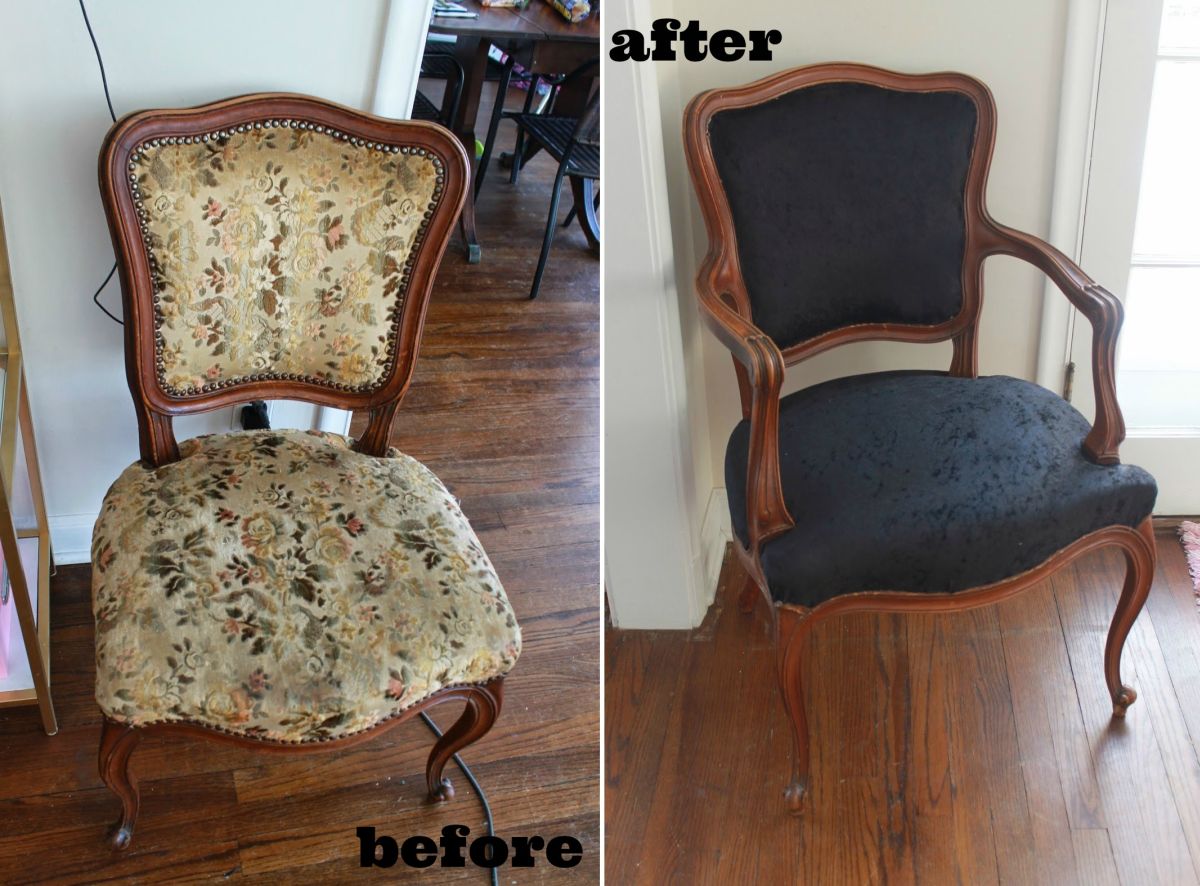
 Beginners Guides3 weeks ago
Beginners Guides3 weeks agoHow to Reupholster a Chair With Buttons
-

 Beginners Guides3 weeks ago
Beginners Guides3 weeks agoHow to Bake Acrylic Paint on Ceramic Mugs
-

 Vetted4 weeks ago
Vetted4 weeks ago15 Best RTA Cabinets to Transform Your Kitchen Space
-

 Vetted3 weeks ago
Vetted3 weeks ago15 Best Care Packages to Show You Care: Thoughtful Gift Ideas for Every Occasion
-

 Vetted4 weeks ago
Vetted4 weeks ago15 Best Backer Boards for Showers to Ensure a Waterproof and Durable Installation
-

 Vetted3 weeks ago
Vetted3 weeks ago15 Best Hypoallergenic Mattresses for a Cozy and Allergy-Free Sleep Experience











